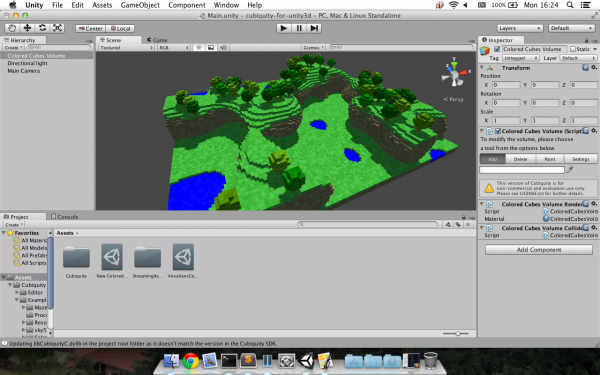The last year has seen a heavy focus on Cubiquity-related news but PolyVox has also been moving along in the background. Here’s a few examples of things we have added over the last year:
- Volume wrap modes (out-of-bounds voxel access can now clamp, repeat, border, etc).
- Improved error handling and logging system, and also timers for performance analysis.
- Pluggable compression and paging support for the LargeVolume class.
None the less, with Cubiquity in the foreground we want to ensure PolyVox does not stagnate, and this Christmas has provided chance for Matt and I to sit down and discuss how to achieve this.
It has become increasingly clear to me that the effort involved in developing a mature open source project is significantly greater than developing a young private project. For example, within Cubiquity I will routinely add, delete, rename, or refactor large swathes of code, safe in the knowledge that I am the only person affected, and that I can roll back large architectural changes without having to justify it to anybody.
In principle PolyVox should be the same – the license clearly states that it’s provided ‘as is’. But in practice there is at least some degree of moral obligation to consider backwards compatibility, communicate significant changes, update the documentation, update the language bindings, test on multiple compilers, etc. This adds a degree of inertia to the project which reduces enthusiasm for making changes, especially in light of having less free time than was previously available.
So, how are we going to fix this? Basically we are planning a few things:
Stop worrying (too much) about API stability: I recently added support for wrap modes and bounds checks when accessing voxels outside of the volume, but this would have changed the interface to the ‘getVoxelAt()’ functions. Therefore I left these functions as they were and added new ‘getVoxel()’ functions. It’s technically backwards compatible, but is also confusing, error-prone, and adds more code to test. In the future we’ll just change things when we feel they need to change.
Embrace C++11 and drop support for older compilers: Matt has long been an advocate of embracing C++11 within PolyVox, and previously we said it would be used after the next stable release. Instead we will start using it now wherever we feel it makes sense. This will result in older versions of Visual Studio being unsupported, and I would guess that VS2012 would become the required version of Windows.
Cut down the amount of code in PolyVox: Some of this will come from the C++11 support – for example we can remove the Boost fallbacks and compiler detection from CMake, replace PolyVox::Array with std::array, etc. Also, the numerous volume, block, and array classes overlap too much in terms of functionality, so we will make some reductions here. We may also strip out the built-in compression code and just let users implement this with an external library.
Simplify build system: We’ll probably drop support for building PolyVox as a dynamic (shared) library, as it’s really not clear that it makes sense when PolyVox is almost entirely header files. We may go header only if we decide it makes sense, as this would then remove the need for people to build PolyVox at all.
Note that we are no longer planning to release a new stable version before commencing work on the above. This may have some impact on users who are trying to keep up with the latest version in Git, but practically speaking the changes are going to be spread out over many months. We’ll also try to keep the develop branch in a relatively stable state and continue to run nightly tests, etc.
PolyVox is still a key piece of software for us as it provides the foundation for Cubiquity, so we do hope these changes help keep it moving forward and allow us to add some of the new features we’ve been thinking about.


